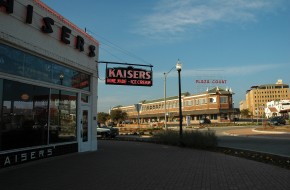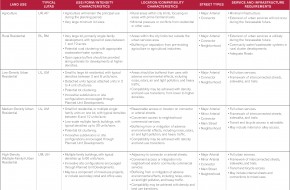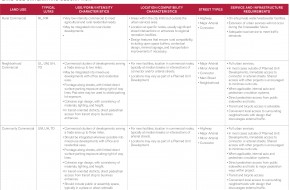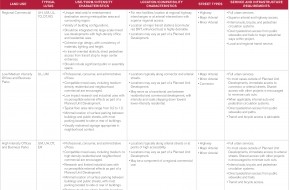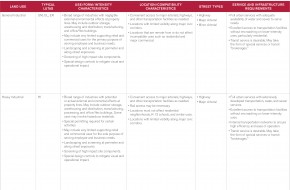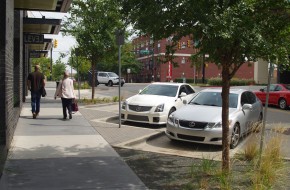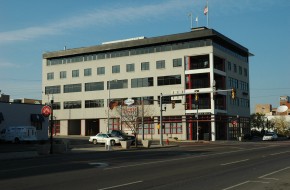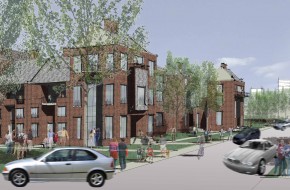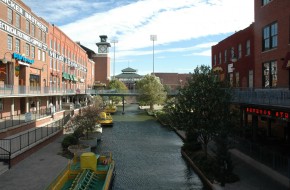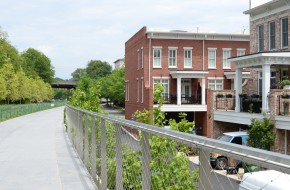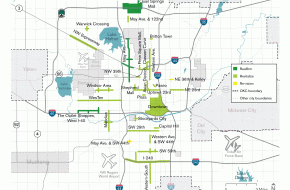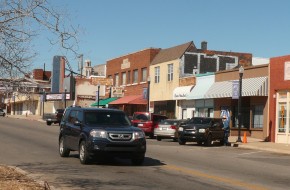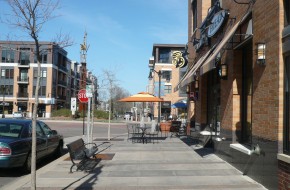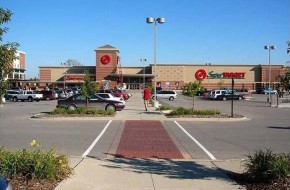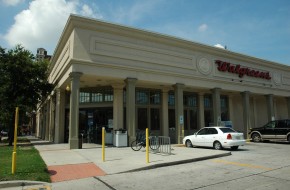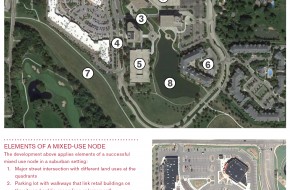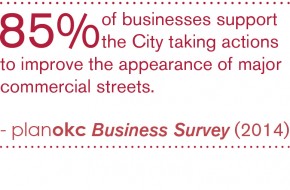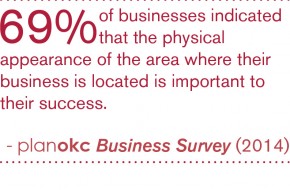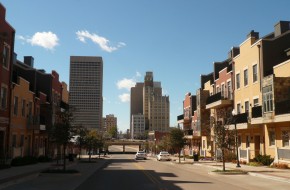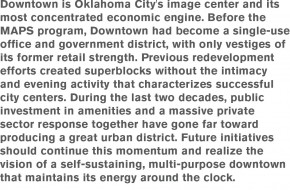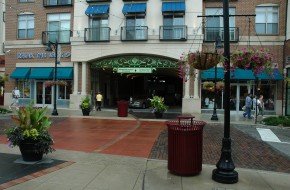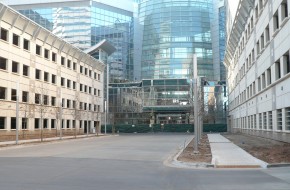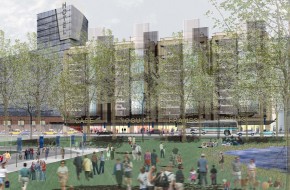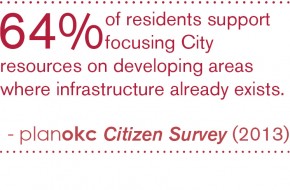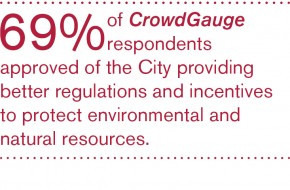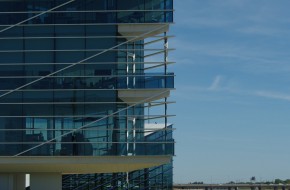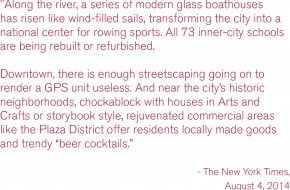Initiatives
Each initiative below summarizes and explains related policies the City and its partners will pursue in order to accomplish goals related to land use. Click on the initiatives below to view full explanations and related policies.
We will develop and implement new land development regulations that support the Land Use Typology Area system of integrated uses and greater flexibility and efficiency. Our current development ordinances date from a time when we valued low density and separation of different land uses higher than city life. The fact that low density increases the cost of services and infrastructure gives us pause. That, combined with our successes at building places that people want to experience has moved us in new directions. The zoning code, which divides the city into 26 single-use “base” districts, 7 special districts, and 16 overlay districts, discourages the trends toward new development forms. We must modernize these codes to implement the LUTA concept and provide both the flexibility and protection that benefit contemporary developers and their neighbors alike.
Despite its large number of specific districts, our zoning ordinance does not provide adequate protections for neighborhoods or guarantees to approving agencies on actual performance or design of projects. This forces the Planning Commission and City Council to use Planned Unit Developments (PUDs), tying developers to a specific project and building design. PUDs are actually intended for a different purpose – to encourage innovative, comprehensively planned developments– and are overly rigid when applied to more routine projects.
Revisions to Oklahoma City’s land development regulations could move in several directions, from modifying existing zoning districts with new performance and design standards to establishing a new structure that uses the Land Use Typology Areas as the basic development districts for the city. The LUTAs, as presented in Chapter Two, permit a variety of uses, but establish permitted ranges of development intensity. The LUTA system achieves compatibility between different types or intensities of uses by implementing performance standards, design guidelines, and transitional methods. These techniques give specific and predictable guidance to builders and developers, and address such areas as operating effects, traffic, parking, design, scale, and safety, avoiding the unnecessary overuse of PUDs. A LUTA-based system would incorporate the criteria for locations and supporting transportation and infrastructure established by this plan for individual land uses.
We will execute a smooth transition between the existing zoning code and new land development ordinances. Development ordinances are complicated and difficult to change because people have become accustomed to them, rough spots and all. Migrating to an alternative concept will take time and care. In the meantime, the City will evaluate using a hybrid approach, mixing the existing zoning districts with the LUTA/mixed use concept. One way of accomplishing this is to group the zoning districts that are consistent with the intensity and use ranges of LUTAs, and apply compatibility policies and design standards to developments within them. The existing zoning ordinance could then be modified to include these compatibility standards. New rezoning requests would be evaluated for consistency with the LUTA in which they are located. If the new project is adjacent to a different land use, the compatibility policies and standards would apply to the design of that project.
Click to expand policy information.
Coordinate the design, development, expansion, and/or investment in transportation projects with the Land Use Typology map.
Require the construction of new streets, streetscapes, and street widening projects to implement the design components of the assigned street typologies established in this plan.
Revise Subdivision Regulations and development standards to reflect the street typology standards.
Routinely assess the City’s development standards, design guidelines, and development review procedures to ensure that they reflect current trends in best-practice and allow for innovative design techniques and evolving methods in low-impact development.
Enhance existing development standards and establish design guidelines for areas outside of the City’s existing Design Review Overlay Districts. Development standards and design guidelines could include the following provisions:
- Minimize views and prominence of parking lots in relation to structures on a site.
- Sense of proportion (street width to building height, human scale)
- Pedestrian orientation of structures and architectural detailing/fenestration
- Terminated vistas
- Reduce the predominance of residential garages in the design of the front facades of single-family residences.
- Inclusion of front porches into the design of residential structures.
- Internal orientation of parking facilities and garages in multi-family developments.
- Improved pedestrian safety and enhanced pedestrian access through parking lots.
Reuse brownfield, greyfield, and other vacant building sites to provide new opportunities for mixed-used and mixed-income housing.
Catalyze the rehabilitation of abandoned structures by amending codes to facilitate the adaptive reuse of existing buildings for residential use.
Develop a City program to rehabilitate or redevelop dilapidated properties, including a land bank to receive donated properties from property owners who can no longer maintain their properties.
Create regulations/standards/guidelines that focus on design and/or compatibility principles which are sensitive to the surrounding urban form, especially in areas that are stable or improving and whose character is well-established. These provisions should also help ensure compatibility between lower- and higher- intensity land uses.
Add legislative priorities for state laws to:
- Strengthen the City’s ability to obtain specific performance of property owners cited for code violations.
- Speed up the demolition process for long-time boarded properties that cannot be rehabilitated.
- Strengthen the City’s ability to require property owners to rehabilitate or sell neglected, boarded-up properties.
- Expedite the clearing of properties involved in probate.
Ensure that safety is factored into the design of neighborhoods through the following policies:
- Incorporate development standards and guidelines into the Subdivision Regulations that integrate the principles of Crime Prevention Through Environmental Design (CPTED) and increase safety and social interaction.
- Create a pre-development checklist with criteria to evaluate how safety is designed into a project.
- Establish a pre-development process wherein safety is considered in the design of projects.
- Involve the Fire and Police Departments in reviewing proposed development and redevelopment to provide input on any safety-related design concerns.
Adopt new citywide site design and building regulations that ensure new developments meet basic functional and aesthetic minimums related to:
- Walkability and bike-ability
- Internal and external street connectivity
- Integration of uses
- Signage
- Building location
- Building appearance
- Open space (passive and active)
Encourage the integration and mixing of land uses in urban areas.
Mitigate negative impacts of compactness by:
- Updating nuisance code to better address noise, smell, vibration, property maintenance, panhandling, animal control, delivery hours limits, and other possible negative effects.
- Updating the sign ordinance to reduce visual clutter.
In order to promote compatibility between different uses, establish standards and guidelines that ensure all developments are pedestrian-friendly and human scale at street frontages and property lines.
Prioritize and concentrate development where facilities, infrastructure, and services have capacity and in areas where the Police and Fire Departments are best able to respond. Guide the location and timing of development through the proactive and strategic installation of infrastructure.
Encourage the integration of different land uses in urban areas through the following means:
- Promote the use of performance standards in place of existing zoning methods (which address incompatibility by separating uses). Performance-based regulations should focus on achieving compatibility between uses by addressing the following:
- Noise, odors and air quality
- Traffic and parking (allow flexible, but sufficient parking)
- Site layout and building design
- Waste
- Safety
- Lighting (glare control, placement, and shielding)
- Delivery hours
- Enhance transit service (bus and rail).
- Prevent large areas of concentration of any particular land use such as multi-family or commercial.
Ensure the ongoing compatibility and appropriateness of development in Planned Unit Developments (PUDs) and Simplified Planned Unit Developments (SPUDs) by:
- Exploring the establishment of expiration dates for PUDs and SPUDs that have not been initiated after a certain period of time;
- Establish a procedure to ensure PUDs build-out according to approved plans.
Enable increased densities as appropriate to individual land use typology areas by addressing financial incentives and disincentives through evaluating the feasibility of strategies such as:
- Impact fees and/or transportation utility fees that vary by district according to actual cost;
- Assessing solid waste charges according to actual cost;
- Private solid waste services where it is impractical for the City to provide service such as in rural areas.
Encourage unified planning for all adjoining land owned or controlled by a project’s developer to ensure proper circulation and land use relationships.
Evaluate existing regulations for effectiveness in promoting density and mixed-use development and in addressing surface parking. Develop a new urban design code for downtown and other key districts to promote healthy mixes of land uses that are compatible and complementary.
Adopt subdivision regulations that ensure new neighborhoods meet the basic needs of residents while supporting an efficient development pattern. Regulations should cover:
- Open space (passive and active),
- Demonstration of sustainable funding levels for common area and facility maintenance costs,
- Walkability and bikeability,
- Internal and external street connectivity,
- Block length,
- Integration of uses,
- Integration of a variety of home sizes,
- Integration of a variety of unit types, and
- Preservation of Environmentally Sensitive Areas.
Regulations could be based on a point scale to allow flexibility, while still requiring basic minimum thresholds be met.
New regulations should remove the existing requirement for development in Rural LUTAs to connect to water and sewer systems and establish a minimum one-acre lot size for lots with on-site sewer treatment.
Revise subdivision and zoning regulations to allow increased densities as appropriate. For example, density potential could be increased by allowing “cottage” or “pocket” neighborhoods and accessory dwelling units (additional dwelling units allowed on owner-occupied properties) where appropriate.
We will ensure that land uses are located on sites that meet their needs, work cohesively in their environments, and are served by appropriate transportation and infrastructure. While the LUTA concept encourages integration of uses, it does not suggest that any land use is appropriate anywhere. Commercial and industrial uses have particular needs for transportation, surrounding conditions, utilities, and visibility. Urban uses in general require water, wastewater, urban streets, and other infrastructure that can meet their demands for service. These individual requirements apply even in mixed-use environments. This makes specific criteria for location and design of individual uses especially important. Developers and builders will use these criteria as they select sites and design projects. Neighborhood residents will be reassured that potentially incompatible uses will be directed to appropriate sites. Approving groups will use criteria to evaluate the quality of development proposals and their compliance with the comprehensive plan. The tables shown on the right present a base for location and development criteria that should be refined and incorporated into new land use ordinances.
We will revise regulations to better protect residential uses from the negative effects of nearby non-residential uses. Traditional development ordinances attempt to shield residential uses from undesirable effects of adjacent uses by separation. Similar development types do tend to cluster together and keeping different uses apart sometimes works. However, use separation by itself produces inefficient and uninteresting development and often is not viewed as providing reliable protection. For example, Oklahoma City frequently uses Planned Unit Developments to control the details of conventional projects. However, the intention of PUDs was to provide flexibility for innovative development rather than inflexible controls on individual sites. Oklahoma City’s new directions in land use planning and regulation instead will create standards and guidelines by which different uses reinforce rather than harm each other.
Certain uses are incompatible and cannot easily be neighbors. The land use system should retain some primary use categories for these situations. But in most cases, transitional standards that encourage mixed-use development and directly control potential incompatibilities should create a more efficient and vital city.
Click to expand policy information.
Coordinate the design, development, expansion, and/or investment in transportation projects with the Land Use Typology map.
Require traffic impact analyses with all comprehensive plan amendments requests to change to a higher intensity LUTA.
Revise Subdivision Regulations and development standards to reflect the street typology standards.
Seek opportunities to co-locate new public projects, such as libraries, fire stations, parks, and recreation centers near compatible civic uses such as schools and campuses to create nodes of activity and services.
Ensure that new publicly financed developments – those which directly use or receive public dollars – with more than 100 units or with densities greater than 10 units/acre are located where they have easy access to frequent transit service.
Modify codes to allow residential clustering in rural land use typology areas, provided water supply and sewage disposal requirements are met, and permanently preserve nearby open space through means such as conservation easements.
Coordinate planning efforts with school districts to attempt concurrent land purchases for schools and parks.
Ensure all homes are within walking distance of a park based on level of service standards for each urban land use typology by updating codes and regulations for new construction and by improving connections and access between existing parks and neighborhoods.
Establish procedures for creating new joint school/park sites, including the division of maintenance responsibilities.
Prioritize capital improvement to construct linkages and connections from the existing urban parks and open space system to neighborhoods, commercial areas, employment centers, and community facilities.
Form a working partnership with the library system, both the Metropolitan Library System and the Oklahoma Department of Libraries, to coordinate timing of facility expansions, improvements, and new facility siting with other types of civic resources, such as schools, fire stations, parks, and projected growth and demand for those resources. This should also include identifying a mechanism to provide library services in Canadian County.
Provide adequate infrastructure for new or expanding companies by giving priority to Capital Improvements in ER areas. Additionally, consider the implementation of impact fees for infrastructure in order to provide infrastructure in a timely manner and to better coordinate with private development.
Encourage the use of special service districts with enhanced levels of service.
Mitigate negative impacts of compactness by:
- Updating nuisance code to better address noise, smell, vibration, property maintenance, panhandling, animal control, delivery hours limits, and other possible negative effects.
- Updating the sign ordinance to reduce visual clutter.
Prioritize and concentrate development where facilities, infrastructure, and services have capacity and in areas where the Police and Fire Departments are best able to respond. Guide the location and timing of development through the proactive and strategic installation of infrastructure.
Encourage the integration of different land uses in urban areas through the following means:
- Promote the use of performance standards in place of existing zoning methods (which address incompatibility by separating uses). Performance-based regulations should focus on achieving compatibility between uses by addressing the following:
- Noise, odors and air quality
- Traffic and parking (allow flexible, but sufficient parking)
- Site layout and building design
- Waste
- Safety
- Lighting (glare control, placement, and shielding)
- Delivery hours
- Enhance transit service (bus and rail).
- Prevent large areas of concentration of any particular land use such as multi-family or commercial.
Higher density multifamily development should be located in areas near employment or educational centers where street and transit systems have, or will soon have capacity to support the added trips.
Avoid concentrations of apartment complexes. Instead, integrate multifamily units into neighborhoods with mixes of housing types or in mixed-use developments.
We will provide incentives and investments that produce a favorable environment for private investment on underutilized sites. In Oklahoma City, we have tended to view land as an inexhaustible and disposable resource, reducing the desirability of older areas and decreasing land values, while expanding the city’s boundaries outward. The surveys and process of planokc show that this view is also changing, as citizens place a high value on using existing infrastructure and urban land effectively and rebuilding established neighborhoods. Preferences are also changing, as many families appreciate active urban places like Midtown and Automobile Alley that provide living, shopping, entertainment, and work places with good walking, bike, and transit access. Effective use of existing land resources is a central principle of Chapter Two’s land use vision.
Redevelopment and infill depend on major private investment. City policy and action can create the conditions that help this private investment occur.
Directions for these policies include:
- Site assembly. Multiple property owners, often absent or very difficult to find, can make it impossible to put together sites for redevelopment. The City can help private developers by helping them assemble sites.
- Infrastructure and street improvement. While redevelopment and infill sites usually have infrastructure, these facilities are sometime obsolete and require improvement. Redevelopment can provide the impetus for making necessary public investments in these assets.
- Public investments. Parks, schools, civic facilities, pedestrian and bicycle facilities, streetscapes, and other amenities can provide anchors that are proven to generate private development. The Bricktown Canal is an excellent example of a public amenity that has paid for itself many times over in private investment. Similarly, the new MAPS 3 Park will inevitably become the catalyst for the Core to Shore redevelopment.
- Code improvement and proactive enforcement. Poor property maintenance, unattractive and cluttered signs, and public or operating nuisances can degrade the value of surrounding property and discourage reinvestment. Updated ordinances and consistent, enforcement will minimize these disincentives and create momentum for new private development.
Click to expand policy information.
Establish new incentives and raise awareness of existing incentives that stimulate the preservation and rehabilitation of historic resources. Incentives could include:
- Preservation easements, low-interest or forgivable rehabilitation loans, and Tax Increment Financing Districts for historic buildings, sites, and districts.
- Tools and practices for public/private partnerships to ensure the preservation and retention of top-priority historic resources whose deterioration or demolition would present an irreparable and highly significant loss to the City and beyond.
- Existing city, state, and federal tools and incentives for rehabilitation, including state and federal tax credits for certified rehabilitation.
- Expedited review process for projects involving infill sites.
Support and incentivize the adaptive use of existing buildings, infill development, and brownfield development.
Modify codes and/or regulations to create opportunities for more income diversity and mixed-income neighborhoods by allowing a variety of housing ownership and leasing arrangements, diverse housing sizes and types – including accessory dwelling units, carriage homes, lofts, live-work spaces, cottages, and manufactured/modular housing. Modifications should allow an increase the variety of ownership opportunities to include condominiums, ownership cooperatives (such as mutual housing associations, limited equity cooperatives, etc.) by identifying and removing regulatory barriers. Recommend improvements to protections for owners, developers, and lenders.
Priority should be given to projects that achieve efficiencies described elsewhere in planokc, such as dwelling units that are located to have easy access to each other and to other daily needs including jobs, recreation, and schools.
Maximize the use of all appropriate state, federal, local, and private funding for the development, preservation, and rehabilitation of housing affordable to a variety of income groups, including those that integrate low-income housing units in otherwise market-rate housing developments and support the creation and/or expansion of mixed-income communities.
Integrate housing rehabilitation programs with neighborhood revitalization programs. These programs should include assistance to property owners to renovate the existing housing stock with improvements that reduce utility and maintenance costs for owners and occupants, conserve energy, conserve water, and reduce greenhouse gas emissions.
Establish new or expand existing financing methods and/or mechanisms available to new and redevelopment mixed-income projects in urban areas. These could include: direct investment of public housing funds, tax-increment financing, bonds, revolving loans, housing program funds and/or other proven public-private partnership models.
Create and/or enhance Community Development Corporations (CDCs) and Community Housing Development Organizations (CHDOs) to increase their capacity to provide mixed-income housing, especially in targeted infill areas.
Reuse brownfield, greyfield, and other vacant building sites to provide new opportunities for mixed-used and mixed-income housing.
Prevent concentration of low-income populations by providing housing opportunities for all income groups in targeted redevelopment areas of the city with a particular focus on mixed-income projects, especially on those projects that have a public funding component.
In conjunction with City regulatory changes, such as significant modifications to zoning ordinances, building codes, or subdivision regulations, assess the effects of the proposed modifications on housing development costs and overall housing affordability, considering the balance between housing affordability and other objectives such as environmental quality, urban design quality, maintenance of neighborhood character and protection of public health, safety and welfare. This assessment should be integrated into the code amendment process, identify barriers to housing affordability, and include recommended mitigation.
Add legislative priorities for state laws to:
- Strengthen the City’s ability to obtain specific performance of property owners cited for code violations.
- Speed up the demolition process for long-time boarded properties that cannot be rehabilitated.
- Strengthen the City’s ability to require property owners to rehabilitate or sell neglected, boarded-up properties.
- Expedite the clearing of properties involved in probate.
Strategically use subsidized housing programs along with other City services and programs to revitalize targeted areas of the city.
Support infill development on vacant, underutilized, and brownfield sites by:
- Allowing densities sufficient to incentivize infill in older areas
- Focusing resources on target neighborhoods to build positive momentum
- Evaluating and adjusting zoning in areas where infill is desired
- Reducing permit fees and processing time for infill development proposals
- Waiving the requirement for traffic impact analyses for infill development proposals
- Establishing an Abandoned Buildings Program and enhancing it over time by:
- Seeking changes in City ordinance and State statute where necessary to allow for cost recovery of police and fire services costs caused by vacant buildings
- Using revenue collected beyond Vacant and Abandoned Buildings program administration cost for neighborhood improvements
- Submitting land bank legislation to the State Legislature and establishing a land bank authorized to acquire, rehabilitate, and dispose of abandoned properties
- Offering temporary or short term catalyzing incentives for the first “infillers” in target neighborhoods. Incentives may include small grants and/or low interest loans from a revolving loan fund or for property improvements.
- Evaluating the possibility of basing property taxes on only land value and not improvements, thereby encouraging high intensity use of well-positioned land and discouraging underutilization and long–term vacancy.
Mitigate negative impacts of compactness by:
- Updating nuisance code to better address noise, smell, vibration, property maintenance, panhandling, animal control, delivery hours limits, and other possible negative effects.
- Updating the sign ordinance to reduce visual clutter.
Prioritize and concentrate development where facilities, infrastructure, and services have capacity and in areas where the Police and Fire Departments are best able to respond. Guide the location and timing of development through the proactive and strategic installation of infrastructure.
Create and implement small area plans for neighborhoods or districts with special strategic importance or complications related to development or redevelopment.
Identify priority areas where the City can maximize private investment by providing public infrastructure and amenities including:
- Transit;
- Parks, trails, sidewalks;
- Streets;
- Arts and cultural facilities.
Encourage redevelopment and infill development on vacant, underutilized, and brownfield sites in urbanized areas.
Catalyze infill development on vacant, underutilized, and brownfield sites in urbanized areas by:
- Investing in infrastructure improvements;
- Improving multi-modal transportation networks;
- Improving parks and open spaces;
- Improving schools and other civic resources;
- Exploring innovative methods such as:
- A public-private partnership to purchase problem properties in target areas and build or rehabilitate homes while improving infrastructure and amenities
- An infill house plan program similar to Sacramento or Milwaukee
- Identifying and removing barriers to rehabilitation and/or replacement of residential buildings.
- Establishing a position in the City to facilitate medium- and large-scale redevelopment projects through the development process by guiding interactions with City departments, allied agencies, and utility companies.
Encourage the adaptive reuse of underutilized structures and the revitalization of older, economically distressed neighborhoods.
We will build housing and neighborhoods that address the needs of citizens at all stages of their lives. Oklahoma City’s citizens and their households have characteristics such as family size, income, age, and tastes that require diverse housing choices. In the past, the majority of new housing development has been single-family, detached, and owner-occupied on relatively large lots. We have also tended to separate housing by type and cost, encouraged by our zoning and subdivision ordinances. However, the private market and resident needs are moving toward greater diversification – different designs, densities, and prices, connected together into neighborhoods. Most housing is built privately, and builders, who respond to markets, cannot be forced to build certain kinds of products. City decisions should encourage both diversity and integration of housing types to the maximum degree possible. Implementing the LUTA concept will help remove statutory obstacles to projects that include diverse housing types and relate them to each other. Updated subdivision regulations will also require the street, pedestrian, and bicycle connectivity, common space, and housing variety needed to turn “pods” into communities.
Design standards can establish a baseline for quality development that respects the needs for both privacy and civic life, and incentives should reward builders and developers who innovate to build diverse, active communities.
Click to expand policy information.
Maximize the use of all appropriate state, federal, local, and private funding for the development, preservation, and rehabilitation of housing affordable to a variety of income groups, including those that integrate low-income housing units in otherwise market-rate housing developments and support the creation and/or expansion of mixed-income communities.
Integrate housing rehabilitation programs with neighborhood revitalization programs. These programs should include assistance to property owners to renovate the existing housing stock with improvements that reduce utility and maintenance costs for owners and occupants, conserve energy, conserve water, and reduce greenhouse gas emissions.
Create and/or enhance Community Development Corporations (CDCs) and Community Housing Development Organizations (CHDOs) to increase their capacity to provide mixed-income housing, especially in targeted infill areas.
Prevent concentration of low-income populations by providing housing opportunities for all income groups in targeted redevelopment areas of the city with a particular focus on mixed-income projects, especially on those projects that have a public funding component.
Create regulations/standards/guidelines that focus on design and/or compatibility principles which are sensitive to the surrounding urban form, especially in areas that are stable or improving and whose character is well-established. These provisions should also help ensure compatibility between lower- and higher- intensity land uses.
In conjunction with City regulatory changes, such as significant modifications to zoning ordinances, building codes, or subdivision regulations, assess the effects of the proposed modifications on housing development costs and overall housing affordability, considering the balance between housing affordability and other objectives such as environmental quality, urban design quality, maintenance of neighborhood character and protection of public health, safety and welfare. This assessment should be integrated into the code amendment process, identify barriers to housing affordability, and include recommended mitigation.
Increase the viability of townhomes and condominiums as housing products by:
- Adopting and supporting new local and state laws to increase consumer protection for condos and townhomes (e.g., better funding mechanisms and maintenance enforcement for common areas).
- Requiring developers to demonstrate sustainable funding levels for common area and facility maintenance costs.
Support diversity and integration of housing unit types and sizes in all land use typology areas in order to meet the diverse needs of households of different sizes, generational needs, incomes, and preferences. New residential subdivisions should achieve a mixture of housing types within a unified development.
Avoid concentrations of apartment complexes. Instead, integrate multifamily units into neighborhoods with mixes of housing types or in mixed-use developments.
Amend the zoning ordinance to better accommodate the integration of various residential densities, building types, and styles.
Create design standards and guidelines for the design, materials, shared amenities, and accessibility of high density urban residential development. Standards and guidelines should promote privacy and livability in a high density, mixed-use environment.
Evaluate existing regulations for effectiveness in promoting density and mixed-use development and in addressing surface parking. Develop a new urban design code for downtown and other key districts to promote healthy mixes of land uses that are compatible and complementary.
Adopt subdivision regulations that ensure new neighborhoods meet the basic needs of residents while supporting an efficient development pattern. Regulations should cover:
- Open space (passive and active),
- Demonstration of sustainable funding levels for common area and facility maintenance costs,
- Walkability and bikeability,
- Internal and external street connectivity,
- Block length,
- Integration of uses,
- Integration of a variety of home sizes,
- Integration of a variety of unit types, and
- Preservation of Environmentally Sensitive Areas.
Regulations could be based on a point scale to allow flexibility, while still requiring basic minimum thresholds be met.
New regulations should remove the existing requirement for development in Rural LUTAs to connect to water and sewer systems and establish a minimum one-acre lot size for lots with on-site sewer treatment.
We will place a priority on increasing the economic strength and growth of viable existing commercial nodes and corridors. Commercial development typically flees to the “next new thing,” leaving previous locations for new sites, usually in growth areas. While understandable, this trend leaves older commercial areas underutilized with more marginal businesses and vacancy, lower rents, and reduced upkeep and investment. While market conditions and age will inevitably make some areas less competitive, we must maintain the strength of our existing viable districts. This program may include:
- Improving the function and convenience of commercial areas with improved transportation access, including better local circulation, enhanced transit service, and internal and external pedestrian and bicycle linkages.
- Creating a better physical environment through streetscape and public space investments.
- Providing financial incentives like tax increment financing for site and building upgrades, and for introduction of new uses into single-use commercial areas.
- Creating new parking standards for mixed-use projects that recognize that different uses generate their highest parking demands at different times.
- Encouraging new commercial within redevelopment areas, benefitting existing retailing by introducing new nearby attractions.
We will implement strategies for the reuse and redevelopment of low-performing commercial areas. Cities don’t stand still and neither do retail markets. Some of the city’s commercial areas are no longer viable in their current form, but still siphon some commercial activity from other, stronger districts. We will implement strategies for revitalization of these underutilized but still important districts.
Click to expand policy information.
Create and implement small area plans for neighborhoods or districts with special strategic importance or complications related to development or redevelopment.
Prioritize maintaining the strength of existing commercial nodes and corridors over providing new areas for commercial development.
Continue promoting the re-use, redevelopment, and revitalization of low-performing or declining commercial areas.
Incentives for new regional retail development should only be considered if the proposed project truly creates a new regional destination for the city and does not significantly cannibalize sales from existing Regional Districts.
Regional-, community-, and neighborhood-scale retail developments should provide an internal vehicle and pedestrian circulation system between new and existing centers and individual stores that draws on the following principles:
- Concentrate access for new retail development at shared primary entrance points. Primary entrance points should be aligned with access points immediately across intersecting roads. Limit curb cuts on primary highways and arterials.
- Provide pedestrian circulation, including sidewalks and median breaks along interior and exterior fronting roads and within parking lots.
- Encourage coordinated development of retail centers in order to facilitate internal pedestrian and vehicle circulation and optimal center performance.
Wayfinding mechanisms and other placemaking features should be strongly encouraged in new and existing commercial districts.
We will establish and execute design guidelines for new commercial projects that enhance appearance, access, and function, and strengthen their surrounding neighborhoods. It seems to many people that one specific priority seems to drive commercial design: getting cars as quickly as possible from the street to parking lots. This produces a common pattern of buildings (shopping centers, multi-tenant strips, free-standing structures) separated from the streets and surrounded by parking, with big signs located along the road for maximum visibility from cars. In fact, zoning and development codes generally focus much more on parking than on the uses and buildings that the parking serves. This generic approach, repeated everywhere, lacks innovation, reduces the customer experience to finding a place to park, and produces inefficient and unattractive commercial strips. However, some new commercial designs are successfully following other approaches, based on providing a good customer experience. Our commercial development standards should also move in this direction. They should guide projects in ways that serve the competitive interests of neighborhoods, developers, businesses, and the entire community.
These guidelines should not micromanage development but instead should follow a few fundamental principles:
- Organizing commercial development as districts to the maximum degree possible. “Districts” allow customers to accomplish several purposes with one trip, to park once and walk comfortably and safely from business to business, and to find features and public amenities that encourage personal interaction and a positive customer experience.
- Engaging commercial buildings and businesses with public streets and sidewalks rather than their parking lots.
- Relating commercial development to surrounding residential neighborhoods, encouraging direct and convenient local access without inviting outside traffic.
- Incorporating mixed land uses such as higher-density residential, services, and offices into commercial projects.
- Developing well-conceived signs and graphics that communicate and guide customers without excessive size and numbers.
- Using site features like landscaping, walkways, internal driveways, and drainage areas to make projects more attractive, secure, and easier for customers to use.
- Reducing the amount of surface area devoted to parking, or dividing parking lots into smaller blocks for circulation and orientation.
We will focus commercial development in nodes that have good transportation access and support the development of multiple uses. Commercial strip development disperses business, working against the creation of walkable, multi-purpose activity centers. Yet, commercial zoning is often granted along these corridors by default, as people assume that their appearance, traffic, and previous land use patterns make them unsuitable for other uses. Nodes are more conducive than strips to pedestrian, bicycle, and transit access and encourage public spaces that upgrade the customer experience. planokc can reshape the character of major corridors, making them good environments for multiple uses. They will also direct commercial development to nodes that provide both good transportation access and opportunities for retailers to reinforce each other. Nodes at intersections may adopt a mixed-use character when non-retail uses are incorporated into at least one quadrant of an intersection.
Click to expand policy information.
Establish regulations that require pedestrian connections between new commercial development and adjoining residential areas.
Share parking among contiguous developments.
Undertake targeted parking studies to determine existing parking capacity and develop appropriate parking standards based on land use, location, and demand.
Initiate new efforts to reduce sign clutter and improve the aesthetics of signs, while allowing for adequate and visible business identification by the following potential measures:
- Restrict new billboards and eliminate or reduce the number of existing billboards.
- Require non-conforming signs to be removed or be brought into compliance with existing regulations within a specific timeframe.
- Consider new standards in the Sign Ordinance to improve limits on the size, height, and number of signs.
- Improve proactive enforcement of the City’s sign regulations to curtail the placement of illegal signs and ensure adequate maintenance of signs.
Develop and adopt new standards/guidelines that result in improvements to parking structure design including the following potential measures:
- Design parking structures to be architecturally integrated with adjoining primary structure(s).
- Include integrated storefronts or other active uses on the ground floors of parking structures that are adjacent to public sidewalks and other pedestrian plazas.
- Enhanced exterior façades of structures by integrating architectural features and materials that complement the character of the surrounding area, or screening with vegetation.
Improve parking provisions in neighborhoods that are near vibrant commercial corridors/areas by improving parking and corridor design, non-vehicular networks, transit, and signage.
Strengthen existing businesses and business districts within and adjacent to established residential areas. Promote the development of new businesses to provide additional jobs and higher income opportunities for nearby residents.
Favor commercial development clustered in nodes at arterial or collector intersections or along brief “main street” style corridors over commercial development extending in a linear pattern for long distances along highway, arterial, or collector corridors.
Regional-, community-, and neighborhood-scale retail developments should provide an internal vehicle and pedestrian circulation system between new and existing centers and individual stores that draws on the following principles:
- Concentrate access for new retail development at shared primary entrance points. Primary entrance points should be aligned with access points immediately across intersecting roads. Limit curb cuts on primary highways and arterials.
- Provide pedestrian circulation, including sidewalks and median breaks along interior and exterior fronting roads and within parking lots.
- Encourage coordinated development of retail centers in order to facilitate internal pedestrian and vehicle circulation and optimal center performance.
Commercial buildings should be built at the street rather than behind a parking lot in order to promote pedestrian circulation, multipurpose shopping trips, and walkable and attractive streetscapes. Large-scale commercial buildings with parking in front should screen parking lots with the coordinated development of out-parcels (pad sites) and with landscaping.
Amend the landscape ordinance to increase the number of trees and landscaped islands required in parking lots.
New neighborhood-scale retail should be located within new residential growth areas to serve daily shopping needs and limit trip distances. In newly developing areas, this retail format is preferred to the existing linear development patterns along arterials.
Neighborhood-scale retail should be developed at the median breaks or intersections of major or minor connectors.
Wayfinding mechanisms and other placemaking features should be strongly encouraged in new and existing commercial districts.
Encourage unified planning for all adjoining land owned or controlled by a project’s developer to ensure proper circulation and land use relationships.
Evaluate existing regulations for effectiveness in promoting density and mixed-use development and in addressing surface parking. Develop a new urban design code for downtown and other key districts to promote healthy mixes of land uses that are compatible and complementary.
We will ensure that new and expanding industries have places to locate and grow in Oklahoma City. The Employment Reserve LUTA designates areas that are especially suitable for major industrial and office development. Public/private partnerships should provide adequate infrastructure and transportation services to these strategic areas. This typology area also recognizes that all land uses do not mix well with each other. Industries must have space to operate responsibly, but have operating characteristics that often are incompatible with other uses. Because industrial and office development may require holding large areas for long periods of time, owners often attempt to realize short-term returns by splitting off parts of sites for commercial or residential uses. If established, these uses can limit industrial and office options. Uses that could compromise future industrial and office growth should not be permitted to encroach on prime land with access to transportation infrastructure that is designated for major employment.
We will reduce the level of land use conflict between industrial and non-industrial uses. Protecting industrial land from non-industrial encroachment is part of a strategy to maintain a sufficient inventory. Reducing the potential for conflict between industrial and other uses also helps maintain the industrial land supply. Industrial development standards and guidelines should include landscaping and screening along major streets and edges of industrial areas, locating higher intensity industries away from neighboring uses, and standards that address building appearance and placement, outdoor storage, and buffering of high-impact site elements.
Click to expand policy information.
Create and promote development-ready sites in Employment (EM) areas using the following strategies:
- Task the Oklahoma Industries Authority (OIA) and/or the Oklahoma City Industrial and Cultural Facilities Trust (OCICFT) to help public and private entities create development-ready sites.
- Partner with the State School Land Trust to prepare their sites located in EM areas for development.
- Pursue public purchase or optioning of key properties in EM areas in cooperation with the Urban Renewal Authority, the Oklahoma Industries Authority (OIA), and/or the Oklahoma City Industrial and Cultural Facilities Trust (OCICFT).
- Conduct a market analysis and feasibility study for a new business park.
- Facilitate development of EM sites by providing:
- Infrastructure financing options, such as tax-increment financing,
- Prioritized delivery of infrastructure, and
- Accelerated or facilitated permitting.
Support development of land designated for large employers and employment centers within the Employment Reserve LUTA, using the following strategies:
- When major infrastructure is extended to allow specific properties to develop in an Employment Reserve area, the City should place a condition on the land (through a development agreement) limiting future development to employment uses.
- Guide employment land development through the proactive and strategic installation of infrastructure to accomplish the large-site employment land inventory objectives outlined in the Employment Land Needs Assessment & Action Plan.
Develop design standards and guidelines for industrial development. Standards and guidelines should address: sensitive design and placement of buildings; screening or prohibiting outdoor storage; parcel sizes which allow for long term expansion for individual users; special landscaping requirements addressing screening and landscaping adjacent to residential areas and along highway and arterial streets; standards for the suitable location, orientation and screening of loading bays; and buffering treatments for truck access points.
Avoid placing heavy industrial uses on borders of industrial areas to avoid conflicts with adjacent development.
Direct oil drilling in industrial areas to locate equipment and facilities near major streets so as to keep interior areas free of obstructions that could hinder industrial development.
We will continue the process of creating a mixed-use, intensively developed, human-scaled, and experience-rich downtown. American downtowns declined as the number of reasons that brought people downtown decreased. Recently, downtowns have achieved success as places to live and visit as well as work. This evolution in Oklahoma City began in Bricktown and surrounding areas, where the canal and ballpark anchored adaptive reuse of historic buildings and the addition of new restaurants, entertainment venues, hotels, offices, and homes. This transformation continued with the addition of one of the National Basketball Association’s premier franchises, the Civic Center restoration, major office projects, and new housing. While the growth and development of downtown will always be ongoing, these accomplishments provide the foundation for building a great 21st century downtown.
Land use and development targets and policies will be instrumental in guiding this future. Major land use focuses will include a range of housing types and costs to serve a complete cross-section of the Oklahoma City market; services and retailing that support a larger resident population, including child care, educational facilities, and neighborhood commercial uses like a grocery store; integration of multiple uses into new and existing buildings; and public parks and open spaces for both programmed and informal activity. Much of this future development will occur on currently under-used sites such as the Core to Shore redevelopment area, the future Boulevard on the former I-40 right-of-way; existing surface parking lots, and vacant sites. Initial steps in meeting these needs include revisions of regulations to accelerate desirable uses and market research to demonstrate and quantify markets for specific project types.
As Downtown continues to develop, it must also evolve as a great urban place that offers a superb experience to its residents, workers, and visitors. The history of the urban renewal era in Oklahoma City tells us that investment dollars and big projects alone do not create a living and vibrant city center. A secure, populated, human-scaled environment requires family-friendly amenities, windows on the street, buildings with details scaled to people, pedestrian environments that engage the eye and mind, and an overall sense of welcoming and even festivity. These features have the power to attract the life that is characteristic of great downtowns.
Click to expand policy information.
Promote the downtown area as an attractive place to live and play for all household types, including families with children by:
- Requiring human scale site and building designs
- Focusing on pedestrian friendliness
- Adding family-friendly public amenities including parks, open space, greenways, plazas, bikeways, public art, etc.
- Limiting noise and protecting privacy
- Ensuring new buildings and sites are designed to be attractive and to enhance safety and the sense of safety.
- Encouraging employment and residential uses in close proximity
- Encouraging or requiring a percentage of condominium or apartment units to be 2 and 3 bedroom units
- Encouraging “child-friendly” development near schools and discouraging uses that could be detrimental to schools’ viability
- Instituting on-street police officers on foot or bicycle to maintain “eyes on the street” and enhance public safety and security
Attract and retain young professionals to downtown and its environs to support and enhance place-making efforts and investments.
- Explore the possibility of the Greater Oklahoma City Chamber of Commerce contracting with the City to facilitate and promote civic engagement and social opportunities for young professionals.
Facilitate the development of housing in the Downtown, Bricktown, and Core to Shore areas in order to increase activity levels and demand for retail and amenities.
Strengthen downtown’s sense of place and activity levels by encouraging more housing, retail, public plazas, public art, parks, indoor recreation facilities, and arts and cultural facilities.
Increase land use diversity in Bricktown to attract and retain visitors and development momentum. Specifically, encourage more retail, office, and recreational uses rather than additional bars and restaurants, so that visitors of all ages and interests will be motivated to visit and stay longer.
In order to promote compatibility between different uses, establish standards and guidelines that ensure all developments are pedestrian-friendly and human scale at street frontages and property lines.
Enhance Downtown Oklahoma City’s prominence by maintaining and increasing its role as the major business center, establishing it as a major urban residential center, and focusing on developing retail, office, entertainment, and arts and cultural uses.
Continue to pursue a full scale downtown grocery store or a natural food grocer by:
- Increasing the amount of downtown housing
- Conducting a market study to quantify existing and future potential
- Promoting downtown to potential store operators
- Providing incentives such as land, infrastructure, or sales tax rebates, and allowing for mixed-use (vertical) integration with other uses including, but not limited to, residential.
Encourage development of new educational and childcare facilities downtown to accommodate families with children that work and/or live downtown.
In Downtown and adjacent areas, encourage the development of affordable housing for moderate-income households through incentives or requirements such as:
- Requiring a percentage of units in all new apartment and condominium developments to be affordable to working households with incomes of 80 to 100 percent of the area median family income as defined by the U.S. Department of Housing and Urban Development. Developments may be exempted through payment of an in-lieu fee to go towards development of affordable housing.
- Establishing a density bonus program where appropriate.
- Establishing financial incentives for development of affordable housing.
Evaluate existing regulations for effectiveness in promoting density and mixed-use development and in addressing surface parking. Develop a new urban design code for downtown and other key districts to promote healthy mixes of land uses that are compatible and complementary.
We will create a high-density downtown by providing efficient parking, excellent automobile, bicycle, and pedestrian circulation, and development policies that promote density.
We know that private automobile transportation and the space that cars require work against high-density development. We also know that downtown must accommodate private cars to succeed, but should provide better alternatives for people moving between features within the district. High density development itself brings more things closer together, making walking, biking (including bike share systems), and transit circulators like modern streetcars the most efficient and pleasant ways to go.
We can institute this “virtuous cycle” by:
- Redeveloping surface parking lots with new development, providing new parking in parking structures, and integrating structured parking vertically into new projects.
- Developing enhanced transit to downtown and “density-friendly” circulation to points within downtown, including pedestrian and bicycle facilities (including bike share) and the modern streetcar circulator included in the MAPS 3 capital program.
- Preserving and restoring to the degree possible the urban grid of blocks in Downtown Oklahoma City, re-establishing pedestrian linkages lost during the superblock era of Downtown redevelopment.
- Revising development ordinances to limit surface parking, encourage mixed uses on at least the street level of parking garages, and increase overall development yields.
Click to expand policy information.
Maintain existing alleys or construct new alleys where feasible to provide trash collection service and parking behind primary buildings and minimize curb cuts along the primary street frontage.
Prohibit new single-use, on-street commercial surface parking lots from locating Downtown and create incentives for the redevelopment of existing commercial surface parking lots with appropriately-scaled infill development.
Provide incentives for developers to build parking garages in high density areas. Include design requirements for projects receiving incentives.
Evaluate existing regulations for effectiveness in promoting density and mixed-use development and in addressing surface parking. Develop a new urban design code for downtown and other key districts to promote healthy mixes of land uses that are compatible and complementary.
We will implement the Core to Shore redevelopment plan. Core to Shore, linking Downtown with the Oklahoma Riverfront, is an exceedingly important project for many reasons. Its 800 acres will develop a completely new, mixed income residential neighborhood that can add up to 10,000 people to the immediate Downtown market. The MAPS 3 Downtown Upper and Lower Parks, other green spaces, and the SkyDance bridge will provide open space and recreation for the entire downtown community and will unite the riverfront greenway and the city center. Finally, the boulevard, convention center, and associated development will heal a barrier that has long divided downtown from its surrounding neighborhoods. Other cities such as Chicago with the redevelopment of the South Loop have demonstrated the dramatic impact of district-wide redevelopment adjacent to a major downtown. Core to Shore is that kind of historic project for Oklahoma City.
Click to expand policy information.
Support infill development on vacant, underutilized, and brownfield sites by:
- Allowing densities sufficient to incentivize infill in older areas
- Focusing resources on target neighborhoods to build positive momentum
- Evaluating and adjusting zoning in areas where infill is desired
- Reducing permit fees and processing time for infill development proposals
- Waiving the requirement for traffic impact analyses for infill development proposals
- Establishing an Abandoned Buildings Program and enhancing it over time by:
- Seeking changes in City ordinance and State statute where necessary to allow for cost recovery of police and fire services costs caused by vacant buildings
- Using revenue collected beyond Vacant and Abandoned Buildings program administration cost for neighborhood improvements
- Submitting land bank legislation to the State Legislature and establishing a land bank authorized to acquire, rehabilitate, and dispose of abandoned properties
- Offering temporary or short term catalyzing incentives for the first “infillers” in target neighborhoods. Incentives may include small grants and/or low interest loans from a revolving loan fund or for property improvements.
- Evaluating the possibility of basing property taxes on only land value and not improvements, thereby encouraging high intensity use of well-positioned land and discouraging underutilization and long–term vacancy.
Enhance Downtown Oklahoma City’s prominence by maintaining and increasing its role as the major business center, establishing it as a major urban residential center, and focusing on developing retail, office, entertainment, and arts and cultural uses.
Work to establish a critical mass of retail uses in the downtown area. A lifestyle center or mixed-use town center presents the most viable option for a major infusion of retail into downtown.
Evaluate existing regulations for effectiveness in promoting density and mixed-use development and in addressing surface parking. Develop a new urban design code for downtown and other key districts to promote healthy mixes of land uses that are compatible and complementary.
We will preserve rural character and grow efficiently by managing the growth of urban development. Without careful phasing of infrastructure extensions and development in new areas, we will continue to use existing infrastructure inefficiently while incurring the higher costs of extending facilities prematurely; create land use conflicts with existing farms; and change the character of land for people who built homes or made other investments based on rural character.
Urban growth will occur in many areas, but these new growth areas should receive infrastructure as the market demands, with incremental utility extensions contiguous to pre-existing urban development. This will require designing and implementing an infrastructure management system, possibly establishing sub-watershed districts which would be opened to development as required by land availability or economic considerations. New basins would be opened to development when existing areas with full services reach a certain percentage of development. In the meantime, areas that can feasibly receive urban infrastructure in the future should be reserved for urban development through the Urban Reserve LUTA.
Infrastructure financing techniques should recognize both the need to manage and direct the geographic extent of development, and the need for partnerships between the public and private sectors to extend services and utilities. For example, the City could provide front-end financing for infrastructure in a specific growth area, reimbursed or offset by impact fees and special service district assessments calculated on the basis of the yield of the area.
We will reinforce the character and quality of existing rural development and provide the ability for some very large lot development in some areas which are unlikely to receive infrastructure in the short term. Oklahoma City has a substantial amount of rural residential development within its city limits. The integrity and rural character of this development should be respected as previous investments in infrastructure are efficiently used. These rural areas also have a significant population that requires convenience and commercial services. Land use policies will provide for limited commercial development to address these specific service needs. The Rural LUTAs specifically recognize that maintaining character, using infrastructure efficiently, and providing supporting commercial are priorities.
While we can plan for sound, gradual expansion of the city through the Urban Reserve LUTA, we should provide existing landowners with the opportunity to realize a reasonable development return on their land. We will consider innovative techniques like Build-Through Acreages, allowing rural density development on a portion of a parcel with adoption of an overall master plan that achieves urban densities when utilities are extended.
Click to expand policy information.
Revise subdivision regulations to include connectivity standards and guidelines that require greater street connectivity, and provide allowances for pedestrian and bicycle connections when street connectivity cannot be made.
Establish access management requirements that limit driveways on arterials and collectors and increase connections between uses to improve safety and traffic efficiency.
Change subdivision regulations to determine the number of entries into a residential development based on number of lots in order to improve connectivity of the roadway network and emergency response.
In order to accommodate desires for large-lot development in Urban Reserve areas, implement innovative techniques such as build-through acreages (otherwise known as shadow platting or ghost platting) that permit interim large-lot development of a site or a portion of a site with a master plan that achieves an overall future density target for urban development.
Prioritize and concentrate development where facilities, infrastructure, and services have capacity and in areas where the Police and Fire Departments are best able to respond. Guide the location and timing of development through the proactive and strategic installation of infrastructure.
Use one or more of the following methods to ensure infrastructure and facility capacities are adequate for proposed development:
- Ongoing master planning to determine the necessary water, sewer, and road infrastructure to serve development.
- An impact fee system that collects funds for specific areas as they develop and installs needed infrastructure in a timely manner.
- Use of special service districts to ensure appropriate levels of service, sufficient revenue, and timely installation of infrastructure and facilities for each district.
- Require developers to construct or fully fund infrastructure or other improvements needed to serve their development, with reasonable accommodation for future adjacent or nearby development.
- Require developers to wait until the City (or the State as the case may be) constructs the infrastructure needed to serve their development.
- For development proposed in areas not currently within one-half mile of existing water infrastructure, require a service area study to first be completed to determine the best method for providing water to the service area.
For development proposed in areas not currently within a sanitary sewer drainage basin, a drainage basin study should first be completed to determine the best method for sanitary sewer service.
Preserve existing rural residential character while pursuing optimal use of existing infrastructure in rural areas.
Ensure that development in rural areas is consistent with local design and scale and does not detract from the open character of the landscape.
Support limited amounts of commercial in rural areas appropriate to the needs of rural residents and passersby. Commercial uses in rural areas should be located in small clusters either on uninterrupted arterials or at freeway interchanges.
Adopt subdivision regulations that ensure new neighborhoods meet the basic needs of residents while supporting an efficient development pattern. Regulations should cover:
- Open space (passive and active),
- Demonstration of sustainable funding levels for common area and facility maintenance costs,
- Walkability and bikeability,
- Internal and external street connectivity,
- Block length,
- Integration of uses,
- Integration of a variety of home sizes,
- Integration of a variety of unit types, and
- Preservation of Environmentally Sensitive Areas.
Regulations could be based on a point scale to allow flexibility, while still requiring basic minimum thresholds be met.
New regulations should remove the existing requirement for development in Rural LUTAs to connect to water and sewer systems and establish a minimum one-acre lot size for lots with on-site sewer treatment.
We will protect key environmental features and use practices that minimize the impact of urban development. Resource protection follows two tracks: maintaining certain environmentally sensitive areas in predominately open uses and minimizing the impact of neighboring development. Policies for areas such as riparian areas and floodplains will preserve the integrity and general open quality of these features. Specific requirements should be fashioned around the characteristics of these resources. For example, floodways should be left as permanent open space, and floodplain development should be avoided.
The parallel track addresses development practices in areas that affect environmental resources. Examples include reducing densities, intensities, and impervious surface of development near environmental resources; incorporating buffers into project design; and prohibiting uses that present pollution risks in important groundwater recharge areas. These practices are discussed more fully in the greenokc chapter.
Land development regulations should advance these practices with both performance requirements and incentives such as conservation development. Conservation development techniques preserve resources within a project area by maintaining openness of sensitive areas and transferring their development potential to other parts of the site.
Click to expand policy information.
Pursue grants, partnerships, and programs that accomplish the following:
- Restore tree stands and wildlife habitats in environmentally sensitive areas.
- Acquire land or establish conservation easements in environmentally sensitive areas to reserve as permanent open space and protect wildlife and habitat.
- Establish a comprehensive habitat management program.
- Provide education and resources for proper use of pesticides and fertilizers, with special focus on encouraging integrated pest management and organic practices.
- Provide education about land management practices that address fire suppression, invasive species, use of herbicides/pesticides, and overgrazing.
- Promote the economic and aesthetic value of preserving Oklahoma City’s natural resources such as riparian areas, Cross Timbers forest, grasslands/prairie, bottomland forests, and wetlands.
Avoid under-grounding streams to the greatest extent possible. Where feasible, encourage the re-surfacing of buried streams. Limit the use of culverts or other structures that alter natural streams, and require designs that minimize impacts to stream health and function.
Using performance standards related to flow quantity, quality, and pattern, modify development regulations, codes, and policies to support the use of green infrastructure/low impact development techniques to mimic natural systems for developments within aquifer recharge zones with moderate or high vulnerability or in areas where streams and riparian areas have been channelized or developed (primarily in the Downtown, UH, and UM LUTAs). Low impact development techniques include but are not limited to:
- Onsite treating or filtering of stormwater contaminants.
- Discharging run-off as sheet-flow after passing through grassy or vegetated open space areas, rather than discharging run-off through concentrated outfalls.
- Creating attractive open space amenities that double as stormwater detention, retention, and / or filtering systems.
- Utilizing pervious pavement, pavers, or asphalt in appropriate locations (i.e. sidewalks, parking spaces, trails, patios, etc.).
- Utilizing planters (at grade or raised), vegetated landscape strips adjacent to roads and parking areas, and alternative curbing designs (allowing stormwater to easily move from impervious areas to pervious areas), to encourage stormwater infiltration and temporary detention.
- Rain Gardens
- Bioswales
- Green streets and alleys
- Green roofs
- Rooftop collection
- Underground detention
- Increased tree canopy preservation/tree planting
- Land/open space conservation
- Cluster development
Establish development regulations to help protect Oklahoma City’s water resources through standards that:
- Require buffers, setbacks, and vegetation conservation requirements to protect riparian and littoral zones and filter waterborne pollutants from development activities and storm water runoff. Buffer widths should be based on water quality function and wildlife habitat needs.
- Encourage natural drainage systems and methods for onsite infiltration and onsite sediment retention.
- Require new developments to maintain or decrease the site’s pre-development runoff rate.
- Allow low-impact development design features such as pervious pavement, rain gardens, landscaped parkways, and alternative curbing designs.
- Reduce the amount of impervious surfaces allowed in buffer zones around Environmentally Sensitive Areas.
- Restore watershed features such as forest, wetlands, and natural stream channels.
Revise policies, codes and development regulations to reduce the risk of damage resulting from flooding and preserve water quality and stream related habitat by avoiding alterations to the 100-year floodplain (as depicted on the FEMA Flood Insurance Rate Map). Allow these areas to remain in their natural state to the greatest extent possible. Revised policies should allow positive alterations, such as restoration of natural riparian areas with appropriate vegetation.
Preserve wetlands in their natural state to the greatest extent possible to increase water quality, minimize quantity of runoff, and increase groundwater recharge. Maintain wetland headwaters and avoid the alteration of surface or subsurface drainage patterns that would eliminate, reduce, or severely alter the frequency and volume of water entering wetland areas.
Develop a comprehensive watershed management strategy that identifies programs, partnerships, actions, and incentives that the City and partners can take to protect the city’s water resources and aquatic areas. The strategy should address the following:
- Creation of a Stormwater Master Plan.
- Update to the City’s sediment control program and establishment of performance measures.
- Coordinated watershed restoration projects.
- Preparation and implementation of Small Watershed Action Plans (SWAPs) and participation in studies to identify needs and opportunities for stream restoration, wetland creation and restoration, and storm water management.
- Identification of opportunities to create wetlands to offset construction and other land development impacts.
- Identification and utilization of “receiving lands” that can absorb storm surge overflows.
- Public education on how to conserve water and minimize chemicals, pathogens, sediment, and nutrients in urban and rural watersheds.
- Acquisition and protection of greenways, river buffers and flood prone areas.
Evaluate the City’s stormwater detention/retention requirements, including the current fee-in-lieu of program, and compare to current best management practices. Based on findings, modify codes, policies and development regulations to update stormwater detention/retention requirements. These requirements should focus on:
- Reducing the risks of property damage due to flooding.
- Managing runoff rates and minimizing stream bank erosion by ensuring that post-development runoff rates do not exceed pre-development rates, even in areas where risks of flooding have historically been low.
- Maintaining surface water quality by managing the release of the first flush stormwater volume in order to encourage settling and filtering of particle and chemical pollutants before releasing water into adjacent water bodies.
Revise development regulations to require the following factors to be addressed in development and redevelopment proposals:
- Preservation of existing natural resources, such as wooded areas, habitat areas, and floodplains.
- Utilization of natural treatments and methods to stabilize or rehabilitate stream and river banks as a means to preserve downstream habitats.
- Integration of a variety of native or compatible non-native, non-invasive plant species.
- Mitigation of impacts of development on habitat, wildlife corridors, riparian and littoral areas, and water quality, through actions such as restoration or re-vegetation of disturbed natural areas and replacement of trees/habitat on-site or off-site.
- Management of invasive plant and animal species.
- Management and maintenance of natural areas, common areas and drainage areas.
- Impact on surface and groundwater supply.
- Impact on water quality caused by land uses and activities.
- Impacts on floodplains, riparian and littoral areas and wetlands and areas with significant landforms.
In areas where standard on-site wastewater systems are not feasible (such as in areas with shallow or poor soils), require very low-density development or development that utilizes conservation design and a centralized treatment facility or other environmentally sensitive systems for wastewater treatment.
Develop a manual of best management practices that can be integrated into City codes. These include, but are not limited to:
- Tree care and management.
- Tree planting.
- Tree protection.
- Street trees (location, conflicts, maintenance, etc. – in addition to general tree care guidelines).
- Placement of utilities (e.g., under streets vs. under park strips)
- Low impact development techniques.
- Habitat protection and restoration.
- Conservation easements and/or subdivisions.
Revise the landscape ordinance to include the following:
- Define terms such as invasive species, exotic/non-native species, and native/indigenous species
- Require removal of invasive species from existing sites, and prohibit such species from being planted or maintained in new development.
- Provide a reference list of native plants and drought-tolerant plants.
- Provide incentives for using native and drought-tolerant plants and disincentives for using high-water plants and turf grass.
- Establish requirements for using design practices that minimize the need for supplemental irrigation.
Preserve natural habitat, maintain wildlife food sources, and reduce the risk of propagating invasive plant species by utilizing vegetation native to Oklahoma, preferably central Oklahoma, for all mitigation and habitat restoration efforts associated with new development and redevelopment projects, public and private, to the greatest extent possible.
Establish an Urban Forestry Program and City Urban Forester position to achieve the following:
- Measure and monitor tree canopy coverage and habitat on a regular basis so that any policies, programs, and regulations may be adjusted accordingly as situations change. Establish a process to maintain current data.
- Develop and maintain regulations, policies, processes, and programs that focus on protection and preservation of native trees.
- Provide assistance with proper tree selection, location, and maintenance to prevent power outages, reduce property damage, and coordinate emergency response during natural disaster events (excessive snow and ice, tornadoes, etc.), address the urban heat island effect, and reduce energy costs, etc.
- Establish programs such as tree give-aways, neighborhood planting programs, and education workshops.
- Provide resources to the public about tree selection, management, and care.
- Seek grant funding for community tree planting to improve City parks, publicly maintained rights-of-way and other areas of the city.
- Inventory the City’s street trees and develop a tree replacement program.
- Partner with volunteer and nonprofit organizations to recruit volunteers for tree planting and maintenance and to coordinate community-wide tree planting efforts.
Develop and adopt a tree preservation ordinance that achieves the following:
- Defines methods of preservation;
- Defines situations where preservation of trees is mandatory versus optional;
- Establishes incentives for tree preservation;
- Establishes mitigation options if preservation cannot be accomplished; and
- Establishes penalties for unauthorized tree removal.
Preserve mature healthy trees and incorporate them into the design of new development or redevelopment projects to the greatest extent possible. Include provisions and best management practices to ensure proper tree protection throughout the construction process. Best management practices include but are not limited to:
- The use of proper pruning techniques;
- Appropriate watering;
- Installation of protective fencing at the drip lines of trees or groups of trees;
- Designated material storage areas; and
- Approved equipment and vehicle parking and maintenance areas.
Provide the public with resources, tools, and guidance to deal with environmental hazards, such as:
- Information about safe disposal options for household contaminants such as motor oils, paints, computers, televisions, batteries, etc.
- Information on environmental hazards, such as brownfield sites.
- Information about funds available to assist with environmental cleanups.
Modify development and subdivision regulations, and City policies to minimize alteration of natural landforms and native vegetation and maximize retention of distinctive natural features for public and private projects.
Coordinate with local, regional, and State agencies to pursue initiatives and regulations that help reduce automobile emissions, such as:
- Transitioning commercial and City fleets to alternative-fueled and hybrid vehicles;
- Determining the feasibility of an idling restriction ordinance for all vehicles.
Establish development regulations that help improve air quality, including:
- Specifying construction controls that reduce airborne dust;
- Increasing landscaping and tree planting to absorb carbon dioxide and air pollutants; and
- Encouraging development patterns and densities that support alternative modes of transportation in the urban LUTAs.
Promote improved air quality and reduced ground-level ozone levels by developing a public education program that will inform residents about the air quality benefits of:
- Proper automobile maintenance
- Proper maintenance and use of gas-powered lawn and garden equipment
- Limiting car idling times
- Alternative fuels
- Alternative / active transportation modes (public transit, walking, biking, car-sharing, etc.)
- Reducing vehicle-miles traveled (VMT)
- Employer sponsored emission reduction programs (carpooling, work from home, telecommuting, etc.)
- Native landscaping (requiring less maintenance)
- Energy efficient housing / buildings
Establish strategies, procedures and policies for City construction projects to achieve higher energy efficiency, including:
- Implementing an energy management plan for City facilities.
- Monitoring energy consumption of City facilities, tracking conservation progress, and communicating results to City administrators, employees, elected officials and the public.
- Assessing water use in City facilities to identify opportunities for conservation and implement appropriate measures.
Partner with agencies, non-profits, and private entities to:
- Implement a sustainable development online forum – an educational and networking resource that will inform the public about local opportunities and the benefits of sustainable development while increasing builder and developer participation.
- Educate citizens on energy and water conservation opportunities both at work and at home.
- Encourage appropriate re-use and reclamation of water in new development and redevelopment to reduce the reliance on potable water use.
- Provide detailed cost-benefit information about green building practices to encourage increased use of such practices in Oklahoma City.
- Reduce reliance on electricity produced by fossil fuel by encouraging the use of renewable energy sources in new development and redevelopment.
- Explore mechanisms (incentives, regulations, programs) to divert demolition debris from landfills and redirect to facilities that can reuse these materials.
- Establish a promotion/award program to showcase innovative development that utilizes low-impact development practices and energy-efficient building techniques / equipment, conserves riparian buffers, and extends greenway networks with hiking/biking trails.
Preserve overall landscape character and natural landforms (rolling hills, native vegetation, etc.) to the greatest extent possible.
Increase the amount of biodiversity-rich green space in urban and suburban areas by:
- Integrating vegetation to support biodiversity in parks, gardens, trails, and green roofs. Native vegetation that provides food and habitat for native wildlife such as “micro prairies” and urban forests will have the greatest effect.
- Encouraging optimal mowing practices on large lots that are adjacent to natural features.
Enrich natural biodiversity in agricultural areas by promoting practices that provide food, water, and habitat for wildlife and minimize negative impacts. Strategies to achieve the goal include:
- Working with farmers, rancher, conservationists, sustainable agricultural organizations, and other stakeholders to develop a plan to conserve nature in farming and ranching landscapes.
- Implementing optimal mowing strategies, which include harvesting grasses at a growing height of 10 plus inches; creating early successional habitat with burning, disking, and haying every 3-5 years; mowing from the center of a field outward to allow wildlife to escape the surrounding areas; adding flushing bars to mowing equipment to minimize bird injuries and death; leaving 4-6 inches of stubble after harvest to capture snow and water; harvesting or mowing after first frost to avoid disturbing bird nests and improve grass quality; and leaving portions of fields as standing crops.
- Increasing nesting habitat.
- Adopting best practices for fertilizer and pesticide applications.
- Developing landscape conservation cooperatives.
- Encouraging grassland ranching as an ecologically beneficial alternative to cultivation, particularly practices such as “mob grazing” that mimic natural grazing patterns.
- Promoting ranching of bison, which benefit conservation efforts by dispersing seeds, increasing plant biodiversity, and enhancing groundwater recharge.
- Restoring grassland on previously cultivated landscapes, particularly in buffer zones near natural features.
- Encouraging and supporting agricultural parks that combine recreation and food production and foster appreciation for agricultural heritage.
- Promoting sustainable intensification, which increases production and profitability while providing rich sources of habitat for biodiversity.
Protect and preserve natural resources, by:
- Identifying and mapping valuable natural resources, such as, native prairies.
- Maintaining a comprehensive inventory and assessment of natural resources and critical habitats.
- Identifying opportunities to create an interconnected green infrastructure network throughout and beyond Oklahoma City’s municipal boundaries via existing trail and greenway projects, parks, stream corridors, and natural areas.
- Seeking the voluntary sale of land or dedication of conservation easements on private land that is identified as critical habitat or is necessary to link wildlife corridors.
- Pursuing protection of strategically identified natural areas by placing them in conservation easements or land banks, and reserving them for future use as open space and passive recreational areas.
- Managing invasive plant and animal species.
- Partnering with applicable State agencies and non-profit entities.
Strive to preserve natural open spaces, including native prairies, and re-plant native vegetation to take advantage of their drought tolerance and deep root structures that slow and adsorb stormwater runoff and reduce erosion by anchoring the soil.
Identify and protect critical habitats for state and federally listed threatened or endangered species.
Establish strategies, procedures and policies that prevent degradation or loss of critical habitat and sensitive areas, such as Cross Timbers, upland forests, wetlands, wildlife corridors, groundwater recharge zones, and riparian areas. Protection methods should ensure that placement of lots, alignment of roads, and installation of structures and infrastructure minimize disturbance of the environmentally sensitive areas using tools such as:
- Directing development to appropriate locations;
- Greenbelt preservation;
- Assurance of no development in protected open space;
- Clustering / conservation subdivisions;
- Pervious surface treatments;
- Density transfers; and/or
- Conservation easements.
Ensure that strategies, procedures, and policies incorporate principles of connectivity, minimal fragmentation, representativeness, and heterogeneity.
Modify codes to allow residential clustering in rural land use typology areas, provided water supply and sewage disposal requirements are met, and permanently preserve nearby open space through means such as conservation easements.
Adopt subdivision regulations that ensure new neighborhoods meet the basic needs of residents while supporting an efficient development pattern. Regulations should cover:
- Open space (passive and active),
- Demonstration of sustainable funding levels for common area and facility maintenance costs,
- Walkability and bikeability,
- Internal and external street connectivity,
- Block length,
- Integration of uses,
- Integration of a variety of home sizes,
- Integration of a variety of unit types, and
- Preservation of Environmentally Sensitive Areas.
Regulations could be based on a point scale to allow flexibility, while still requiring basic minimum thresholds be met.
New regulations should remove the existing requirement for development in Rural LUTAs to connect to water and sewer systems and establish a minimum one-acre lot size for lots with on-site sewer treatment.
























 Download PDF
Download PDF